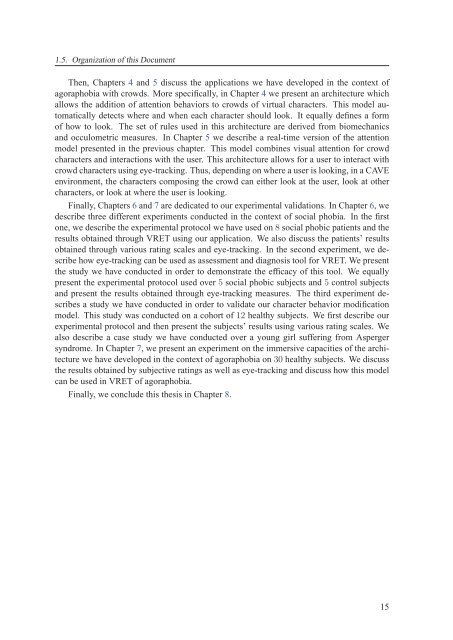Texte intégral / Full text (pdf, 20 MiB) - Infoscience - EPFL
Texte intégral / Full text (pdf, 20 MiB) - Infoscience - EPFL
Texte intégral / Full text (pdf, 20 MiB) - Infoscience - EPFL
Create successful ePaper yourself
Turn your PDF publications into a flip-book with our unique Google optimized e-Paper software.
1.5. Organization of this Document<br />
Then, Chapters 4 and 5 discuss the applications we have developed in the con<strong>text</strong> of<br />
agoraphobia with crowds. More specifically, in Chapter 4 we present an architecture which<br />
allows the addition of attention behaviors to crowds of virtual characters. This model automatically<br />
detects where and when each character should look. It equally defines a form<br />
of how to look. The set of rules used in this architecture are derived from biomechanics<br />
and occulometric measures. In Chapter 5 we describe a real-time version of the attention<br />
model presented in the previous chapter. This model combines visual attention for crowd<br />
characters and interactions with the user. This architecture allows for a user to interact with<br />
crowd characters using eye-tracking. Thus, depending on where a user is looking, in a CAVE<br />
environment, the characters composing the crowd can either look at the user, look at other<br />
characters, or look at where the user is looking.<br />
Finally, Chapters 6 and 7 are dedicated to our experimental validations. In Chapter 6,we<br />
describe three different experiments conducted in the con<strong>text</strong> of social phobia. In the first<br />
one, we describe the experimental protocol we have used on 8 social phobic patients and the<br />
results obtained through VRET using our application. We also discuss the patients’ results<br />
obtained through various rating scales and eye-tracking. In the second experiment, we describe<br />
how eye-tracking can be used as assessment and diagnosis tool for VRET. We present<br />
the study we have conducted in order to demonstrate the efficacy of this tool. We equally<br />
present the experimental protocol used over 5 social phobic subjects and 5 control subjects<br />
and present the results obtained through eye-tracking measures. The third experiment describes<br />
a study we have conducted in order to validate our character behavior modification<br />
model. This study was conducted on a cohort of 12 healthy subjects. We first describe our<br />
experimental protocol and then present the subjects’ results using various rating scales. We<br />
also describe a case study we have conducted over a young girl suffering from Asperger<br />
syndrome. In Chapter 7, we present an experiment on the immersive capacities of the architecture<br />
we have developed in the con<strong>text</strong> of agoraphobia on 30 healthy subjects. We discuss<br />
the results obtained by subjective ratings as well as eye-tracking and discuss how this model<br />
can be used in VRET of agoraphobia.<br />
Finally, we conclude this thesis in Chapter 8.<br />
15

















